2023-2024学年冀教版英语九年级全一册Unit 4 Stories and Poems单元知识清单学案(含解析)
文档属性
| 名称 | 2023-2024学年冀教版英语九年级全一册Unit 4 Stories and Poems单元知识清单学案(含解析) | 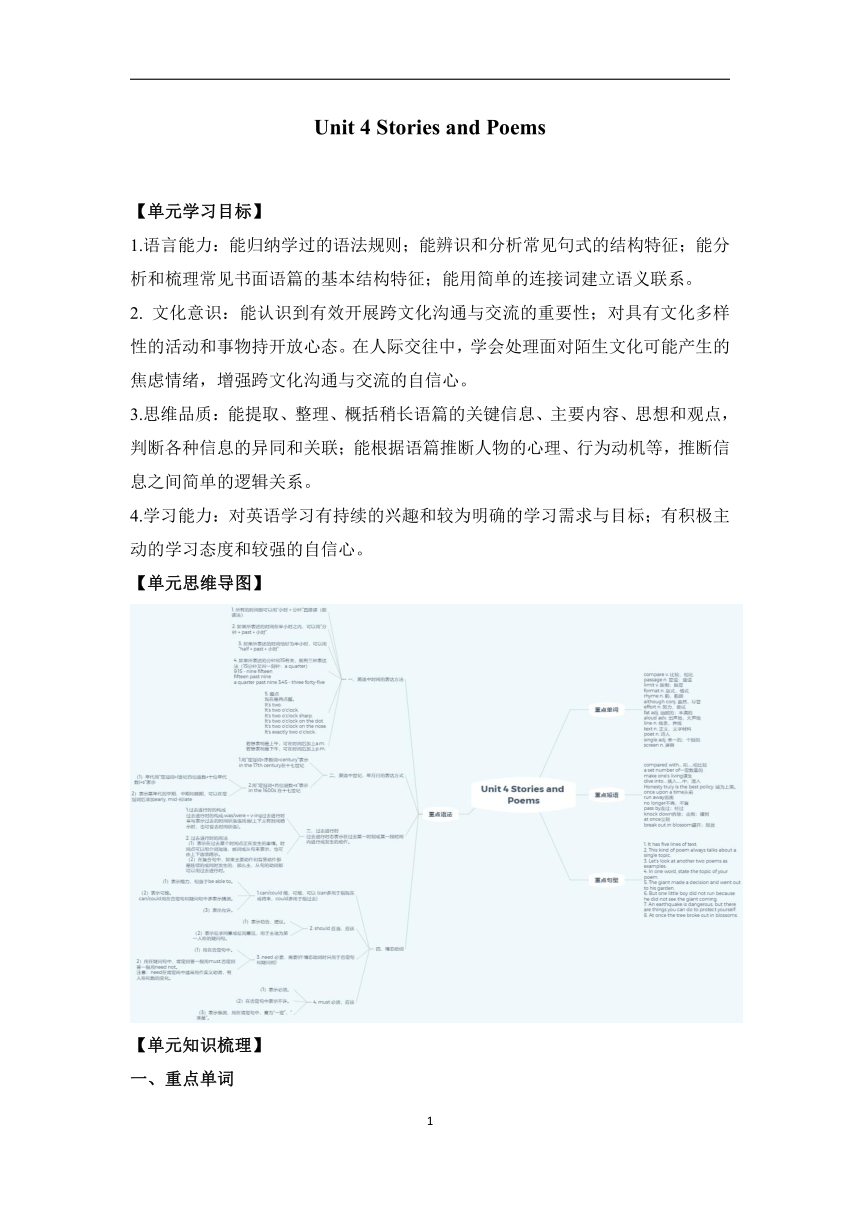 | |
| 格式 | docx | ||
| 文件大小 | 177.9KB | ||
| 资源类型 | 教案 | ||
| 版本资源 | 冀教版 | ||
| 科目 | 英语 | ||
| 更新时间 | 2023-11-01 20:11:46 | ||
图片预览

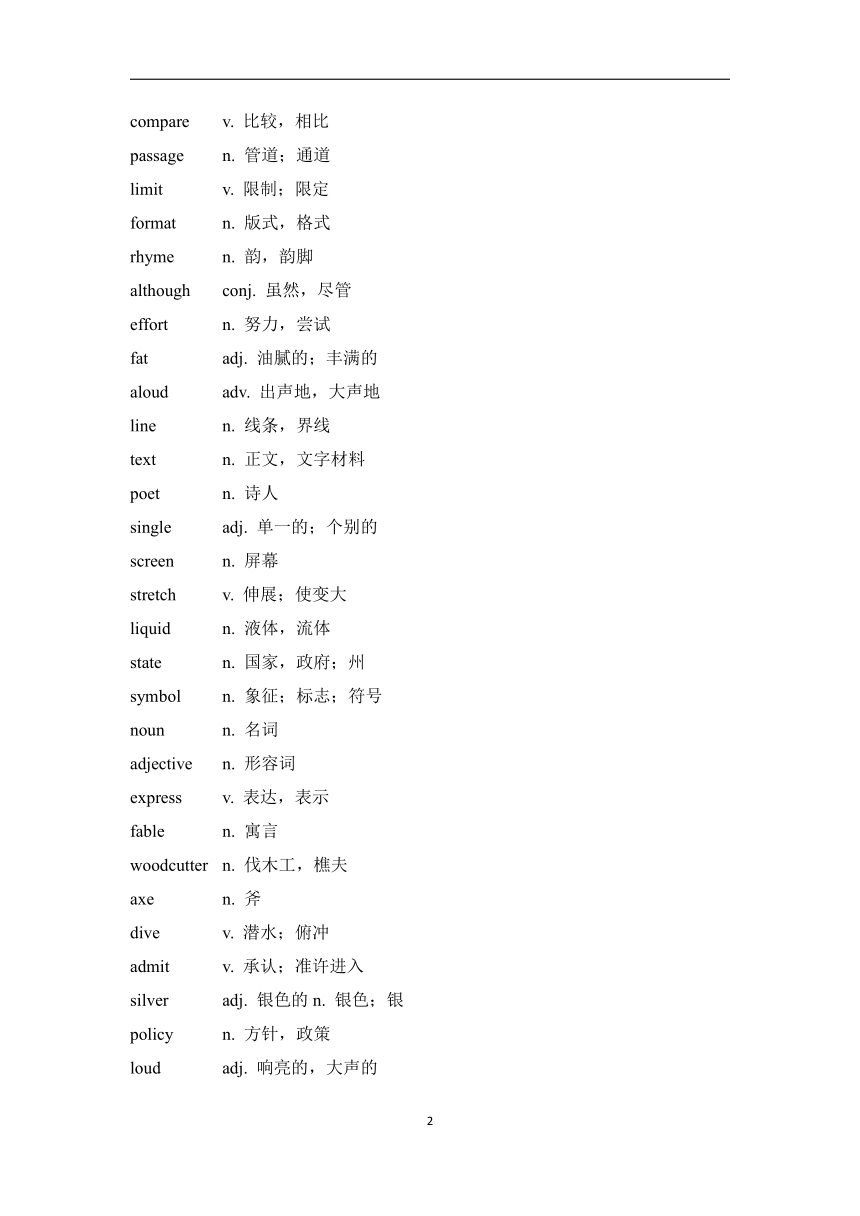
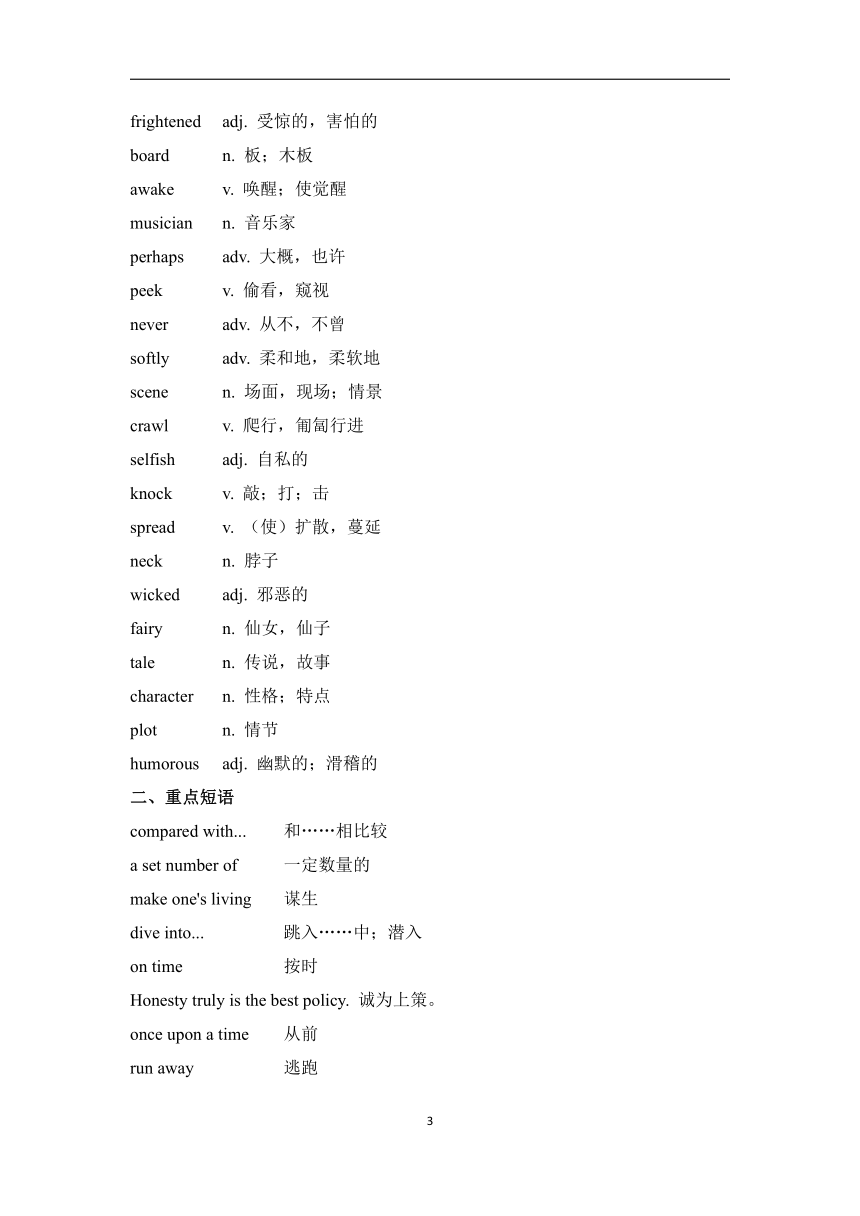
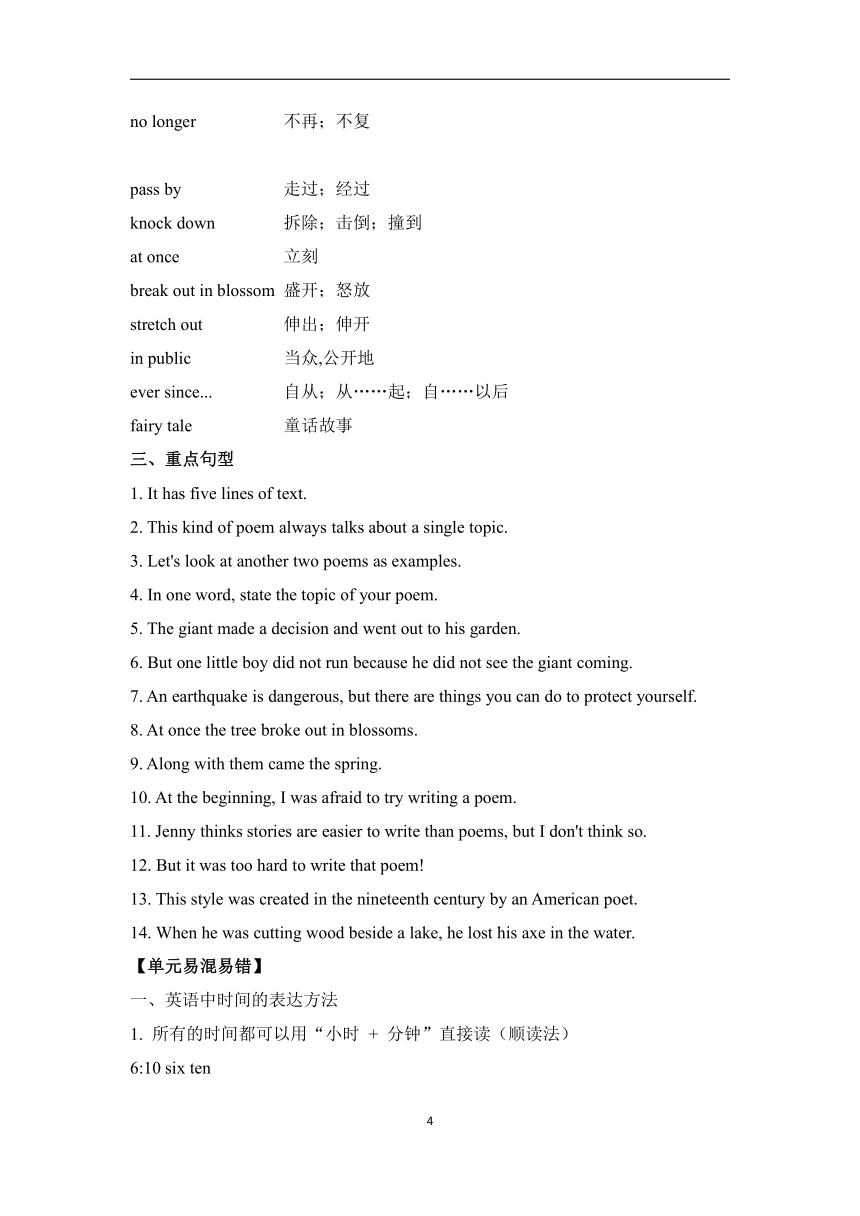
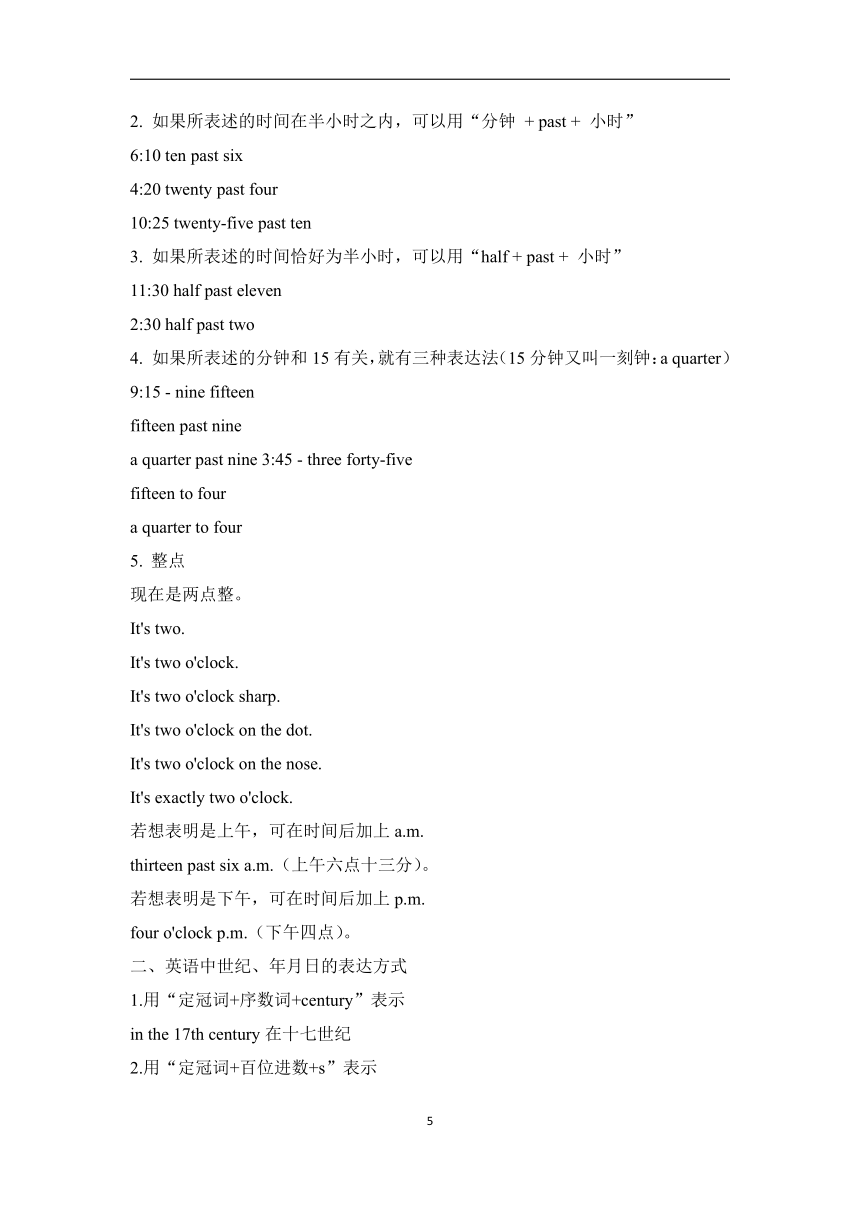
文档简介
Unit 4 Stories and Poems
【单元学习目标】
1.语言能力:能归纳学过的语法规则;能辨识和分析常见句式的结构特征;能分析和梳理常见书面语篇的基本结构特征;能用简单的连接词建立语义联系。
2. 文化意识:能认识到有效开展跨文化沟通与交流的重要性;对具有文化多样性的活动和事物持开放心态。在人际交往中,学会处理面对陌生文化可能产生的焦虑情绪,增强跨文化沟通与交流的自信心。
3.思维品质:能提取、整理、概括稍长语篇的关键信息、主要内容、思想和观点,判断各种信息的异同和关联;能根据语篇推断人物的心理、行为动机等,推断信息之间简单的逻辑关系。
4.学习能力:对英语学习有持续的兴趣和较为明确的学习需求与目标;有积极主动的学习态度和较强的自信心。
【单元思维导图】
【单元知识梳理】
一、重点单词
compare v. 比较,相比
passage n. 管道;通道
limit v. 限制;限定
format n. 版式,格式
rhyme n. 韵,韵脚
although conj. 虽然,尽管
effort n. 努力,尝试
fat adj. 油腻的;丰满的
aloud adv. 出声地,大声地
line n. 线条,界线
text n. 正文,文字材料
poet n. 诗人
single adj. 单一的;个别的
screen n. 屏幕
stretch v. 伸展;使变大
liquid n. 液体,流体
state n. 国家,政府;州
symbol n. 象征;标志;符号
noun n. 名词
adjective n. 形容词
express v. 表达,表示
fable n. 寓言
woodcutter n. 伐木工,樵夫
axe n. 斧
dive v. 潜水;俯冲
admit v. 承认;准许进入
silver adj. 银色的n. 银色;银
policy n. 方针,政策
loud adj. 响亮的,大声的
frightened adj. 受惊的,害怕的
board n. 板;木板
awake v. 唤醒;使觉醒
musician n. 音乐家
perhaps adv. 大概,也许
peek v. 偷看,窥视
never adv. 从不,不曾
softly adv. 柔和地,柔软地
scene n. 场面,现场;情景
crawl v. 爬行,匍匐行进
selfish adj. 自私的
knock v. 敲;打;击
spread v. (使)扩散,蔓延
neck n. 脖子
wicked adj. 邪恶的
fairy n. 仙女,仙子
tale n. 传说,故事
character n. 性格;特点
plot n. 情节
humorous adj. 幽默的;滑稽的
二、重点短语
compared with... 和……相比较
a set number of 一定数量的
make one's living 谋生
dive into... 跳入……中;潜入
on time 按时
Honesty truly is the best policy. 诚为上策。
once upon a time 从前
run away 逃跑
no longer 不再;不复
pass by 走过;经过
knock down 拆除;击倒;撞到
at once 立刻
break out in blossom 盛开;怒放
stretch out 伸出;伸开
in public 当众,公开地
ever since... 自从;从……起;自……以后
fairy tale 童话故事
三、重点句型
1. It has five lines of text.
2. This kind of poem always talks about a single topic.
3. Let's look at another two poems as examples.
4. In one word, state the topic of your poem.
5. The giant made a decision and went out to his garden.
6. But one little boy did not run because he did not see the giant coming.
7. An earthquake is dangerous, but there are things you can do to protect yourself.
8. At once the tree broke out in blossoms.
9. Along with them came the spring.
10. At the beginning, I was afraid to try writing a poem.
11. Jenny thinks stories are easier to write than poems, but I don't think so.
12. But it was too hard to write that poem!
13. This style was created in the nineteenth century by an American poet.
14. When he was cutting wood beside a lake, he lost his axe in the water.
【单元易混易错】
一、英语中时间的表达方法
1. 所有的时间都可以用“小时 + 分钟”直接读(顺读法)
6:10 six ten
2. 如果所表述的时间在半小时之内,可以用“分钟 + past + 小时”
6:10 ten past six
4:20 twenty past four
10:25 twenty-five past ten
3. 如果所表述的时间恰好为半小时,可以用“half + past + 小时”
11:30 half past eleven
2:30 half past two
4. 如果所表述的分钟和15有关,就有三种表达法(15分钟又叫一刻钟:a quarter)
9:15 - nine fifteen
fifteen past nine
a quarter past nine 3:45 - three forty-five
fifteen to four
a quarter to four
5. 整点
现在是两点整。
It's two.
It's two o'clock.
It's two o'clock sharp.
It's two o'clock on the dot.
It's two o'clock on the nose.
It's exactly two o'clock.
若想表明是上午,可在时间后加上a.m.
thirteen past six a.m.(上午六点十三分)。
若想表明是下午,可在时间后加上p.m.
four o'clock p.m.(下午四点)。
二、英语中世纪、年月日的表达方式
1.用“定冠词+序数词+century”表示
in the 17th century在十七世纪
2.用“定冠词+百位进数+s”表示
in the 1600s 在十七世纪
(1)年代用“定冠词+(世纪百位进数+十位年代数)+s”表示
in the 1930s在二十世纪三十年代
(2)表示某年代的早期、中期和晚期,可以在定冠词后添加early, mid-和late
in the early 1920s 在二十世纪二十年代早期
三、过去进行时
过去进行时态表示在过去某一时刻或某一段时间内进行或发生的动作。
1.过去进行时的构成
过去进行时的构成:was/were + v-ing过去进行时常与表示过去的时间状语连用当(上下文有时间暗示时,也可省去时间状语)。
We were having supper when the phone rang.
电话响铃时我们正在吃晚饭。
The giant saw that more children were crawling through a hole in the wall.
巨人看到,更多的孩子从墙上的洞里爬了出来。
We were watching TV from seven to nine last night.
昨晚我们从七点一直看电视到九点。
What was she doing in the countryside all day last Sunday
上周日她整天在乡下干什么?
2. 过去进行时的用法
(1)表示在过去某个时间点正在发生的事情。时间点可以用介词短语、副词或从句来表示,也可由上下语境暗示。
What was she doing at nine o'clock yesterday (介词短语表示时间点)
她昨天九点在做什么?
When I saw him, he was watering his flowers in his garden. (when从句表示时间点)
当我看到他时,他正在花园里浇花。
(2)在复合句中,如果主要动作和背景动作都是延续的或同时发生的,那么主、从句的动词都可以用过去进行时。
While she was waiting for the bus she was reading a newspaper. (两个动作都是延续的)
她读着报纸等公交。
She was cleaning her car while I was cooking. (两个动作同时进行)
我做饭时,她正清理她的车。
四、情态动词
1.can/could 能,可能,可以 (can多用于指现在或将来,could多用于指过去)
(1)表示能力,相当于be able to。
I can make noodles myself.
我能自己煮面。
Sorry, I can't follow you. Please say that again.
不好意思,我没跟上。请再说一遍。
Can people prevent certain accidents
人们可以预防某些事故吗?
The girl could speak English when she was a child.
这个女孩还小的时候就能说英语。
(2)表示可能。
Smoking can cause diseases of the lungs.
吸烟可能导致肺部疾病。
Some of the disadvantages can become real problems if we don't take care.
如果我们不加以注意,其中的一些弊端可能会成为真正的问题。
can/could用在否定句和疑问句中多表示猜测。
The girl can't be so careless.
这个女孩不可能这么粗心。
There is someone outside. Who can it be
有人在外面。会是谁?
It couldn't be true.
这不能是真的。
Could it be her
会是她吗?
Where could Amy be at that time
Amy当时会在哪里?
(3)表示允许。
Can I speak to Jenny
我能跟Jenny说话吗?
Can you send me a photo of yourself
能给我一张你的照片吗?
You can go.
你可以去。
could代替can.语气显得更加委婉。
Could you open the door for me, please
能请你帮我打开这扇门吗?
Could you speak more loudly
你能再大声点吗?
Could I help you
需要帮助吗?
2. should 应当,应该
(1)表示劝告、建议。
We should go to the hospital right now.
我们应该现在就去医院。
As a student, you should never smoke.
作为一名学生,你绝不能吸烟。
You shouldn't be so careless.
你不应该这么粗心大意。
(2)表示征求同意或征询意见,用于主语为第一人称的疑问句。
Should I open the window
要不要打开窗户?
When should we have the meeting
我们要开会吗?
What should I do to be a polite guest
我应该怎样做才能成为一个有礼貌的客人?
3. need 必要,需要(作情态动词时只用于否定句和疑问何)
(1)用在否定句中。
Amy, you needn't get up so early.
Amy,你不用起这么早。
We needn't worry about her.
我们不需要担心她。
(2)用在疑问句中,肯定回答一般用must,否定回答一般用need not。
--Need we eat foods from each food group
--Yes, you must.
--Need the guests leave the place right away
--No, they needn't.
注意:need在肯定向中通常用作实义动调,有人称和数的变化。
He needs to take an X-ray.
4. must 必须,应该
(1)表示必须。
In a poem every word must have power and meaning.
在一首诗中,每一个字都必须具有力量和意义。
We must do everything carefully.
我们必须小心行事。
(2)在否定句中表示不许。
Cars mustn't be parked here.
此处禁止停车。
(3)表示推测,用在肯定句中,意为“一定”,“准是”。
She thought it must be the king's musicians passing by.
她想,一定是国王的乐师路过了。
注意:回答带有must 的一般疑问的时,否定回答常用need not,而不用must not。
--Must the students be back by four o'clock
--Yes, they must. (No. they needn't.)
【单元对接中考】
1.【2021年北京】—_________I take photos here
—Sorry, you can't. It's not allowed in the museum.
A. Must B. Need C. Can D. Will
2.【2021年北京】I ______about my sister when my phone rang. It was her!
A. think B. will think C. was thinking D. am thinking
3.【2022年安徽】—Hey, Tom, you are making noise. You should be polite ______.
—Sorry, Mum. I've got it.
A.at most B.in public C. on time D.by chance
4.【2022年天津】The book ______ be Mary's. We can see her name on it.
A. need B. must C. can't D. needn't
5.【2022年天津】Although he failed many times, he ______ gave up his dream.
A. nearly B. never C. often D. always
6. 【2023年天津】People all over the world love pandas, and the panda has become a ________ of China.
A. festival B. poem C. guest D. symbol
7.【2023年天津】—Would you like to visit Tianjin University tomorrow
—Sorry, I'm afraid I ________, I'll work as a volunteer in my community.
A. can B. can’t C. must D. mustn’t
8.【2023年天津】While we ________ an English song, some visitors came to our class.
A. sing B. will sing C. were singing D. are singing
答案以及解析
1.答案:C
解析:本题考查情态动词的用法。根据答语可知, 此处表示"我能在这儿拍照吗"。can可表示"可以", 用于请求允许, 符合题意。
2.答案:C
解析:本题考查动词的时态。根据语境可知, 此处表示"我正想着姐姐时电话铃响了", 再结合题干中的"It was her"可知, 此处应用过去进行时, 故选C。
3.答案:B
解析:本题考查短语的用法。此处是说, 你在公共场合应该有礼貌。at most至多, 不超过; in public当众, 公开地; on time按时; by chance偶然。故选B。
4.答案:B
解析:本题考查情态动词的用法。根据题干中的"We can see her name on it"可知, 此处表示"这本书一定是玛丽的"。表示有把握的肯定推测应用must。
5.答案:B
解析:本题考查副词的辨析。句意: 尽管他失败了很多次, 但是他从未放弃他的梦想。nearly"几乎"; never"从未"; often"经常"; always"总是"。根据句意可知B项符合语境。
6.答案:D
解析:本题考查名词。结合常识可知,大熊猫是中国的象征,a symbol of...意为"……的象征",符合题意,故选D。festival"节日";poem"诗,韵文";guest"客人,宾客"。
7.答案:B
解析:本题考查情态动词。根据答语中的"I'll work as a volunteer in my community"可知,答话人明天没法去参观天津大学,故can't"不能"符合题意。
8. 答案:C
解析:本题考查动词的时态。根据题干中的"came"可知,从句的时态应与过去相关,故选C。
2
【单元学习目标】
1.语言能力:能归纳学过的语法规则;能辨识和分析常见句式的结构特征;能分析和梳理常见书面语篇的基本结构特征;能用简单的连接词建立语义联系。
2. 文化意识:能认识到有效开展跨文化沟通与交流的重要性;对具有文化多样性的活动和事物持开放心态。在人际交往中,学会处理面对陌生文化可能产生的焦虑情绪,增强跨文化沟通与交流的自信心。
3.思维品质:能提取、整理、概括稍长语篇的关键信息、主要内容、思想和观点,判断各种信息的异同和关联;能根据语篇推断人物的心理、行为动机等,推断信息之间简单的逻辑关系。
4.学习能力:对英语学习有持续的兴趣和较为明确的学习需求与目标;有积极主动的学习态度和较强的自信心。
【单元思维导图】
【单元知识梳理】
一、重点单词
compare v. 比较,相比
passage n. 管道;通道
limit v. 限制;限定
format n. 版式,格式
rhyme n. 韵,韵脚
although conj. 虽然,尽管
effort n. 努力,尝试
fat adj. 油腻的;丰满的
aloud adv. 出声地,大声地
line n. 线条,界线
text n. 正文,文字材料
poet n. 诗人
single adj. 单一的;个别的
screen n. 屏幕
stretch v. 伸展;使变大
liquid n. 液体,流体
state n. 国家,政府;州
symbol n. 象征;标志;符号
noun n. 名词
adjective n. 形容词
express v. 表达,表示
fable n. 寓言
woodcutter n. 伐木工,樵夫
axe n. 斧
dive v. 潜水;俯冲
admit v. 承认;准许进入
silver adj. 银色的n. 银色;银
policy n. 方针,政策
loud adj. 响亮的,大声的
frightened adj. 受惊的,害怕的
board n. 板;木板
awake v. 唤醒;使觉醒
musician n. 音乐家
perhaps adv. 大概,也许
peek v. 偷看,窥视
never adv. 从不,不曾
softly adv. 柔和地,柔软地
scene n. 场面,现场;情景
crawl v. 爬行,匍匐行进
selfish adj. 自私的
knock v. 敲;打;击
spread v. (使)扩散,蔓延
neck n. 脖子
wicked adj. 邪恶的
fairy n. 仙女,仙子
tale n. 传说,故事
character n. 性格;特点
plot n. 情节
humorous adj. 幽默的;滑稽的
二、重点短语
compared with... 和……相比较
a set number of 一定数量的
make one's living 谋生
dive into... 跳入……中;潜入
on time 按时
Honesty truly is the best policy. 诚为上策。
once upon a time 从前
run away 逃跑
no longer 不再;不复
pass by 走过;经过
knock down 拆除;击倒;撞到
at once 立刻
break out in blossom 盛开;怒放
stretch out 伸出;伸开
in public 当众,公开地
ever since... 自从;从……起;自……以后
fairy tale 童话故事
三、重点句型
1. It has five lines of text.
2. This kind of poem always talks about a single topic.
3. Let's look at another two poems as examples.
4. In one word, state the topic of your poem.
5. The giant made a decision and went out to his garden.
6. But one little boy did not run because he did not see the giant coming.
7. An earthquake is dangerous, but there are things you can do to protect yourself.
8. At once the tree broke out in blossoms.
9. Along with them came the spring.
10. At the beginning, I was afraid to try writing a poem.
11. Jenny thinks stories are easier to write than poems, but I don't think so.
12. But it was too hard to write that poem!
13. This style was created in the nineteenth century by an American poet.
14. When he was cutting wood beside a lake, he lost his axe in the water.
【单元易混易错】
一、英语中时间的表达方法
1. 所有的时间都可以用“小时 + 分钟”直接读(顺读法)
6:10 six ten
2. 如果所表述的时间在半小时之内,可以用“分钟 + past + 小时”
6:10 ten past six
4:20 twenty past four
10:25 twenty-five past ten
3. 如果所表述的时间恰好为半小时,可以用“half + past + 小时”
11:30 half past eleven
2:30 half past two
4. 如果所表述的分钟和15有关,就有三种表达法(15分钟又叫一刻钟:a quarter)
9:15 - nine fifteen
fifteen past nine
a quarter past nine 3:45 - three forty-five
fifteen to four
a quarter to four
5. 整点
现在是两点整。
It's two.
It's two o'clock.
It's two o'clock sharp.
It's two o'clock on the dot.
It's two o'clock on the nose.
It's exactly two o'clock.
若想表明是上午,可在时间后加上a.m.
thirteen past six a.m.(上午六点十三分)。
若想表明是下午,可在时间后加上p.m.
four o'clock p.m.(下午四点)。
二、英语中世纪、年月日的表达方式
1.用“定冠词+序数词+century”表示
in the 17th century在十七世纪
2.用“定冠词+百位进数+s”表示
in the 1600s 在十七世纪
(1)年代用“定冠词+(世纪百位进数+十位年代数)+s”表示
in the 1930s在二十世纪三十年代
(2)表示某年代的早期、中期和晚期,可以在定冠词后添加early, mid-和late
in the early 1920s 在二十世纪二十年代早期
三、过去进行时
过去进行时态表示在过去某一时刻或某一段时间内进行或发生的动作。
1.过去进行时的构成
过去进行时的构成:was/were + v-ing过去进行时常与表示过去的时间状语连用当(上下文有时间暗示时,也可省去时间状语)。
We were having supper when the phone rang.
电话响铃时我们正在吃晚饭。
The giant saw that more children were crawling through a hole in the wall.
巨人看到,更多的孩子从墙上的洞里爬了出来。
We were watching TV from seven to nine last night.
昨晚我们从七点一直看电视到九点。
What was she doing in the countryside all day last Sunday
上周日她整天在乡下干什么?
2. 过去进行时的用法
(1)表示在过去某个时间点正在发生的事情。时间点可以用介词短语、副词或从句来表示,也可由上下语境暗示。
What was she doing at nine o'clock yesterday (介词短语表示时间点)
她昨天九点在做什么?
When I saw him, he was watering his flowers in his garden. (when从句表示时间点)
当我看到他时,他正在花园里浇花。
(2)在复合句中,如果主要动作和背景动作都是延续的或同时发生的,那么主、从句的动词都可以用过去进行时。
While she was waiting for the bus she was reading a newspaper. (两个动作都是延续的)
她读着报纸等公交。
She was cleaning her car while I was cooking. (两个动作同时进行)
我做饭时,她正清理她的车。
四、情态动词
1.can/could 能,可能,可以 (can多用于指现在或将来,could多用于指过去)
(1)表示能力,相当于be able to。
I can make noodles myself.
我能自己煮面。
Sorry, I can't follow you. Please say that again.
不好意思,我没跟上。请再说一遍。
Can people prevent certain accidents
人们可以预防某些事故吗?
The girl could speak English when she was a child.
这个女孩还小的时候就能说英语。
(2)表示可能。
Smoking can cause diseases of the lungs.
吸烟可能导致肺部疾病。
Some of the disadvantages can become real problems if we don't take care.
如果我们不加以注意,其中的一些弊端可能会成为真正的问题。
can/could用在否定句和疑问句中多表示猜测。
The girl can't be so careless.
这个女孩不可能这么粗心。
There is someone outside. Who can it be
有人在外面。会是谁?
It couldn't be true.
这不能是真的。
Could it be her
会是她吗?
Where could Amy be at that time
Amy当时会在哪里?
(3)表示允许。
Can I speak to Jenny
我能跟Jenny说话吗?
Can you send me a photo of yourself
能给我一张你的照片吗?
You can go.
你可以去。
could代替can.语气显得更加委婉。
Could you open the door for me, please
能请你帮我打开这扇门吗?
Could you speak more loudly
你能再大声点吗?
Could I help you
需要帮助吗?
2. should 应当,应该
(1)表示劝告、建议。
We should go to the hospital right now.
我们应该现在就去医院。
As a student, you should never smoke.
作为一名学生,你绝不能吸烟。
You shouldn't be so careless.
你不应该这么粗心大意。
(2)表示征求同意或征询意见,用于主语为第一人称的疑问句。
Should I open the window
要不要打开窗户?
When should we have the meeting
我们要开会吗?
What should I do to be a polite guest
我应该怎样做才能成为一个有礼貌的客人?
3. need 必要,需要(作情态动词时只用于否定句和疑问何)
(1)用在否定句中。
Amy, you needn't get up so early.
Amy,你不用起这么早。
We needn't worry about her.
我们不需要担心她。
(2)用在疑问句中,肯定回答一般用must,否定回答一般用need not。
--Need we eat foods from each food group
--Yes, you must.
--Need the guests leave the place right away
--No, they needn't.
注意:need在肯定向中通常用作实义动调,有人称和数的变化。
He needs to take an X-ray.
4. must 必须,应该
(1)表示必须。
In a poem every word must have power and meaning.
在一首诗中,每一个字都必须具有力量和意义。
We must do everything carefully.
我们必须小心行事。
(2)在否定句中表示不许。
Cars mustn't be parked here.
此处禁止停车。
(3)表示推测,用在肯定句中,意为“一定”,“准是”。
She thought it must be the king's musicians passing by.
她想,一定是国王的乐师路过了。
注意:回答带有must 的一般疑问的时,否定回答常用need not,而不用must not。
--Must the students be back by four o'clock
--Yes, they must. (No. they needn't.)
【单元对接中考】
1.【2021年北京】—_________I take photos here
—Sorry, you can't. It's not allowed in the museum.
A. Must B. Need C. Can D. Will
2.【2021年北京】I ______about my sister when my phone rang. It was her!
A. think B. will think C. was thinking D. am thinking
3.【2022年安徽】—Hey, Tom, you are making noise. You should be polite ______.
—Sorry, Mum. I've got it.
A.at most B.in public C. on time D.by chance
4.【2022年天津】The book ______ be Mary's. We can see her name on it.
A. need B. must C. can't D. needn't
5.【2022年天津】Although he failed many times, he ______ gave up his dream.
A. nearly B. never C. often D. always
6. 【2023年天津】People all over the world love pandas, and the panda has become a ________ of China.
A. festival B. poem C. guest D. symbol
7.【2023年天津】—Would you like to visit Tianjin University tomorrow
—Sorry, I'm afraid I ________, I'll work as a volunteer in my community.
A. can B. can’t C. must D. mustn’t
8.【2023年天津】While we ________ an English song, some visitors came to our class.
A. sing B. will sing C. were singing D. are singing
答案以及解析
1.答案:C
解析:本题考查情态动词的用法。根据答语可知, 此处表示"我能在这儿拍照吗"。can可表示"可以", 用于请求允许, 符合题意。
2.答案:C
解析:本题考查动词的时态。根据语境可知, 此处表示"我正想着姐姐时电话铃响了", 再结合题干中的"It was her"可知, 此处应用过去进行时, 故选C。
3.答案:B
解析:本题考查短语的用法。此处是说, 你在公共场合应该有礼貌。at most至多, 不超过; in public当众, 公开地; on time按时; by chance偶然。故选B。
4.答案:B
解析:本题考查情态动词的用法。根据题干中的"We can see her name on it"可知, 此处表示"这本书一定是玛丽的"。表示有把握的肯定推测应用must。
5.答案:B
解析:本题考查副词的辨析。句意: 尽管他失败了很多次, 但是他从未放弃他的梦想。nearly"几乎"; never"从未"; often"经常"; always"总是"。根据句意可知B项符合语境。
6.答案:D
解析:本题考查名词。结合常识可知,大熊猫是中国的象征,a symbol of...意为"……的象征",符合题意,故选D。festival"节日";poem"诗,韵文";guest"客人,宾客"。
7.答案:B
解析:本题考查情态动词。根据答语中的"I'll work as a volunteer in my community"可知,答话人明天没法去参观天津大学,故can't"不能"符合题意。
8. 答案:C
解析:本题考查动词的时态。根据题干中的"came"可知,从句的时态应与过去相关,故选C。
2
同课章节目录
